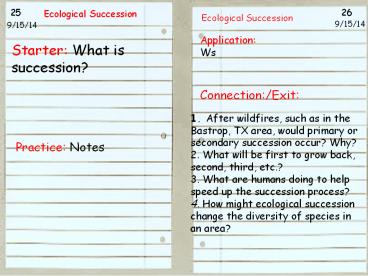Ecological Succession - PowerPoint PPT Presentation
1 / 19
Title:
Ecological Succession
Description:
Ecological Succession ... 11-12 8/29 Levels of Organization 13-14 9/02 Symbiotic Relationships 15-16 9/03 Abiotic and Biotic Factors 17-18 9/4-5 ... – PowerPoint PPT presentation
Number of Views:573
Avg rating:3.0/5.0
Title: Ecological Succession
1
25
26
Ecological Succession
Ecological Succession
9/15/14
9/15/14
Application Ws Connection/Exit
Starter What is succession?
1. After wildfires, such as in the Bastrop, TX
area, would primary or secondary succession
occur? Why? 2. What will be first to grow back,
second, third, etc.? 3. What are humans doing to
help speed up the succession process? 4. How
might ecological succession change the diversity
of species in an area?
Practice Notes
2
Table of Contents
Date Lecture/ Activity/ Lab
Page 8/27 Syllabus /Notebook Guidelines 1-2 8/27
Periodic Table/ Formula 3-4 8/27
Tools/ Measurement 5-6 8/27
Lab Report/ Investigations 7-8 8/27
Restroom passes/Homework Log 9-10 8/28
Testing a hypothesis
11-12 8/29 Levels of Organization
13-14 9/02 Symbiotic
Relationships 15-16 9/03
Abiotic and Biotic Factors 17-18 9/4-5
Ecosystems Research and Poster 19-20 9/8
Flow of Energy
21-22 9/10-11 Food Web Poster
23-24 9/15 Ecological
Succession 25-26
3
Agenda
- 1. Starter
- 2. Notes
- 3. Activity
- 4. Exit
4
Changes in EcosystemsEcological Succession
5
What is Ecological Succession?
- Natural, gradual changes in the types of species
that live in an area - Can be primary or secondary
- The gradual replacement of one plant community by
another through natural processes over time
6
Primary Succession
- Begins in a place without any soil
- Sides of volcanoes
- Landslides
- Flooding
- First, lichens that do not need soil to survive
grow on rocks - Next, mosses grow to hold newly made soil
- Known as PIONEER SPECIES
7
Pioneer Species
Low, growing moss plants trap moisture and
prevent soil erosion
Lichens break down rock to form soil.
8
Primary Succession
- Soil starts to form as lichens and the forces of
weather and erosion help break down rocks into
smaller pieces - When lichens die, they decompose, adding small
amounts of organic matter to the rock to make
soil
9
(No Transcript)
10
Primary Succession
- Simple plants like mosses and ferns can grow in
the new soil
11
Primary Succession
- The simple plants die, adding more organic
material (nutrients to the soil) - The soil layer thickens, and grasses,
wildflowers, and other plants begin to take over
12
Primary Succession
- These plants die, and they add more nutrients to
the soil - Shrubs and trees can survive now
13
Primary Succession
- Insects, small birds, and mammals have begun to
move into the area - What was once bare rock, now supports a variety
of life
14
Secondary Succession
- Begins in a place that already has soil and was
once the home of living organisms - Occurs faster and has different pioneer species
than primary succession - Example after forest fires
15
(No Transcript)
16
(No Transcript)
17
(No Transcript)
18
Climax Community
- A stable group of plants and animals that is the
end result of the succession process - Does not always mean big trees
- Grasses in prairies
- Cacti in deserts
19
25
26
Ecological Succession
Ecological Succession
9/15/14
9/15/14
Application Ws Connection/Exit
Starter What is succession?
1. After wildfires, such as in the Bastrop, TX
area, would primary or secondary succession
occur? Why? 2. What will be first to grow back,
second, third, etc.? 3. What are humans doing to
help speed up the succession process? 4. How
might ecological succession change the diversity
of species in an area?
Practice Notes































